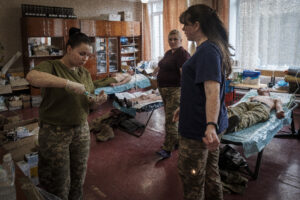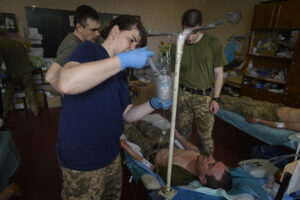But the Airborne Brigade told us that we could take just about any photographs we wanted, and interview pretty much anyone we felt like. And I told them that what the Kyiv Post wanted to do was see enlisted soldiers doing their jobs, if at all possible.
So, when ambulances delivered two batches of injured infantrymen to the Brigade CPC, and doctors and nurses jumped into action, Kyiv Post photographer Christopher Occhicone and I were present as observers. We tried to stay out of the way.
The 25th Brigade’s CPC is on the ground floor, several rooms in a government building used by medical staff to process and treat most, but not all, of its soldiers hit in combat badly enough to be taken off the frontline to receive serious medical assistance.
The really bad cases, requiring complicated surgery or other risky life-saving work, get carried by ambulance straight to a city hospital beefed up with military doctors and nurses.

Olena Saprykina preparing an IV while medical workers treat a group of men with severe concussion as a result of Russian artillery
at the 25th Airbourne Brigade Casualty Reception Center, Donetsk Region, Ukraine, May 10, 2022 (Photo Credit: Christopher Occhicone / Redux) (Christopher Occhicone/Redux)
Chris and I were told that the town hospital is fully capable of handling 99% of the worst combat injuries, though some of the equipment is old.
At the CPC where we were, a team of nurses and doctors treat soldiers who are wounded but – probably – not in a life-threatening condition. The day we were there, about a dozen kilometers to the east, a powerful RF munition (or munitions) hit fighting line positions manned by 25th Brigade infantryman. All told, eight men were evacuated by ambulance.
The CPC is four or five cots laid out in a well-lit room, with shelves along the walls filled with medical supplies. Each cot has a stand for an IV, and on each IV stand is an empty water bottle cut in half to hold a reserve IV bag.

Medical worker treats a group of men with severe concussion as a result of Russian artillery at the 25th Airbourne Brigade Casualty Reception Center, Donetsk Region, Ukraine, May 10, 2022 (Photo Credit: Christopher Occhicone / Redux) (Christopher Occhicone/Redux)
On each of the four was a Ukrainian soldier, with each man stripped to the waist. They were mostly young,
in their twenties, but one man appeared to be in his thirties and one was old enough to have gray in his beard.
All were dirty and disoriented, but aside from bruising I couldn’t see any visible injuries on them. All looked, to a greater or lesser degree, fearful and confused, not dissimilar to the way a person looks after a bad automobile accident. A nurse told me all four were concussion cases.
They all seemed to be in pain, and one man, he looked like the worst-hit, was rolling side to side and groaning. Every once in a while, he would look around the room. My guess is it was the instinct to look for help.
He had blue eyes. It’s tough to meet the eyes of a person in pain saying “do something for me if you can”, and your job is to watch.
But it’s far, far tougher to be smashed by an explosion powerful enough to throw a grown man into the air, rip the clothes off his back, and leave him weak and hoping very, very much that some stranger will help him.
Two or three doctors were in the background, but a nurse team of three women in their 30s and 40s, and one in her 20s, did basically all of the work. Each man was gently interviewed, and if he still had clothes on above his waist they were removed.
A nurse patted down each man, particularly the stomach and chest, looking for signs of damaged internal organs or bleeding. Modern equipment for scanning a patient like an X-Ray machine or sonogram machine was not in the room.
The worse hit soldier received an Electrocardiography by a nurse using a Soviet-era heart monitor system dating back to the 1950s, with rubber bulbs as suction cups for attaching the individual listening sensors to the man’s chest.
A nurse told me that if necessary a wounded soldier can get scans from modern equipment at the city hospital. The main function of the CDC, she said, was to treat and keep stable injured soldiers who, most likely, need mostly rest and monitoring to recover from what hurt them in the fighting.
At present, mostly, the 25th Brigade’s CDC sets bones, picks shell splinters that didn’t penetrate too deeply out of soldiers bodies and frequently handles concussion cases.
Following checks for damaged internal organs, the main concussion treatment seemed to be painkillers fed through an IV. It seemed to work quickly and the soldiers told the nurses, who checked every few minutes, that the pain was subsiding.
Meanwhile the nurses checked ears for damage from explosions, and repeated those checks to see if lost hearing was returning. In some cases it was quickly, in some cases it wasn’t.
The way the nurses worked wasn’t like it is in the movies. Nobody was running, no-one was shouting the Ukrainian version of “Stat!”, medical supplies weren’t being flung everywhere, no soldier was so far gone in pain he had to be physically restrained, outsiders weren’t ordered out of the room, there was no dramatic fumbling by the pretty young new nurse to put in an IV into the arm of a handsome soldier.
The work was smooth. It was quite obvious these women had processed wounded soldiers many times before. They worked methodically, step-by-step, and constantly talking to each other: “this man needs his internals checked”, “that man is good to make his way to the recovery room”, “make sure you note that man has ringing in his ears”.
Later on I found out that the 25th Brigade has been fighting since day one of the war and suffering casualties almost constantly. The CPC staff can ask for a day off, but very rarely does anyone take one.
I spoke with an ambulance driver named Oleksandr, a reservist mobilized into service back in April. He drives a civilian Peugeot ambulance donated by civilian group sending assistance to Ukraine. He apologized for the vehicle’s condition, but the roads in the sector, he explained, are extremely bad, ambulances must drive as fast as possible, and that quickly demolishes anything with wheels not fully capable of serious off-roading.
He told me the pick-up and delivery of the next four wounded, also concussed from an explosion, went relatively smoothly. Fortunately, his run back from the fighting line to the CDC met no Russian artillery fire.
Sometimes, Oleksandr has to run a gauntlet of explosions to get the wounded away from the fighting line. One ambulance I saw had personal flak vests hung over the driver’s and passenger’s window to protect the driver from shell splinters.
The civilian ambulances donated by Ukrainian and Western help groups are saving lives, Oleksandr told me, but their patient compartments are are not equipped with any armor.
But the visit did not pass without one of those weird wartime coincidences.
One of the soldiers, a tall man in his 20s with a curly black beard, was a little better off than the rest. He seemed to recover quickly, and as the painkillers did their work, he was on his feet and talking to one of the doctors.
He kept looking at me, which reporters get used to as a stranger among people in distress. He finally called me over and told me he was pretty sure he knew me.
We compared notes, and yes, it turned out during in the late 2000s he had served in the 36th Marine Brigade at the same time I was a US member of the OSCE’s international mission monitoring the Donbas conflict in the Mariupol sector.
Our OSCE patrols would pass through the Marine positions from time to time, I frequently led the patrols and when I did I was the OSCE guy that wound up talking to the Marines.
Apparently I had been through his checkpoint or interviewed his commander several times. I didn’t remember him.
His name is Ruslan. Now Ruslan is in the 25th Airborne Brigade and I’m working for the Kyiv Post.
After the second group of four wounded were treated the youngest nurse, a 20-year old woman by the name of Olena, did not go for a rest but instead sat down with the head nurse and one of the doctors, and went through the personal details of each of the injured, making sure everything was right.
There had been some minor discrepancies in information about the wounded reported from the field to the CPC.
The executive officer of the whole brigade, a lieutenant colonel who over the day had showed himself to be a pretty jovial man with a well-developed sense of humour and a relaxed approach to command, got on the radio and phone and in hard tones told subordinates on the other end to nail down details about the wounded.
“The 25th Brigade demands that information about the wounded must be accurate, the first time, no exceptions,” he underlined.
Ruslan was standing on his own when I left.
The doctor told me he was going to be just fine after resting a few days, and there was a warm building with food and warmth and plenty of support staff to take care of him, before he goes back to the line.
The chances we will ever see each other again are basically zero.
We shook hands, wished each other luck, told each other to stay safe, and went our separate ways.
Source:kyivpost.com/ukraine